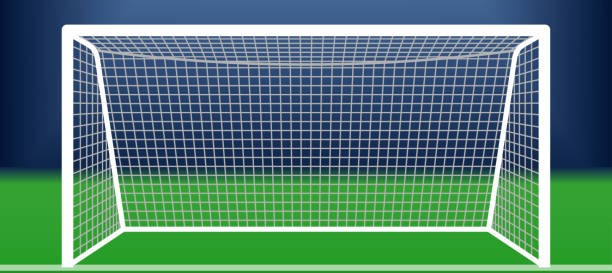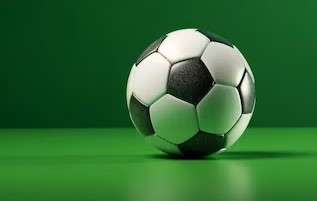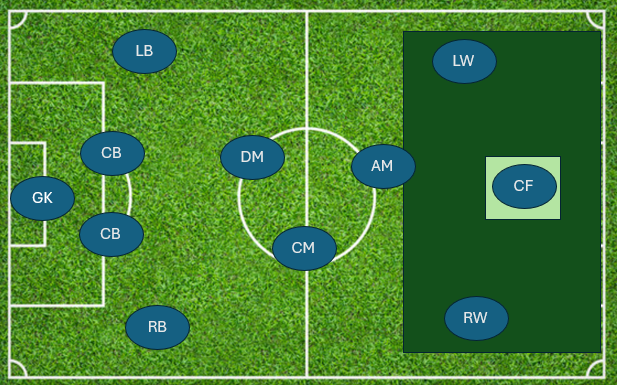













THE STRIKER.

The striker (also known as the center forward or attacker) is one of the most important positions
in football, with a primary focus on scoring goals. The striker is positioned closest to the opponent’s goal and is
expected to capitalize on goal-scoring opportunities. Here’s a detailed explanation of the role and
responsibilities of the striker:
Primary Role: Scoring Goals:
- ▫ MAIN RESPONSIBILITY: The striker’s primary job is to score goals. They are positioned in the attacking zone
and are expected to finish attacking plays by taking shots on goal.
- ▫ GOAL POACHER: Strikers often stay near the opponent’s penalty area, looking for chances to score from crosses,
through balls, or rebounds. They need to be able to react quickly and capitalize on even the smallest mistakes by defenders
Positioning and Movement:
- ▫ ADVANCED POSITION: Strikers usually play at the top of the formation, ahead of the midfielders and wingers.
They are often the furthest forward, standing near the opposition’s defenders, ready to receive the ball and attack.
- ▫ OFF-THE-BALL MOVEMENT: A good striker constantly moves to create space for themselves or their teammates.
This includes running behind the defense to receive a pass, dropping deeper to link up play, or pulling defenders
out of position to open up space for others.
- ▫ STAY ON THE SHOULDER OF DEFENDERS: Strikers often position themselves on the shoulder of the last defender, waiting for
the right moment to make a run behind the defensive line to latch onto a pass.
Hold-Up Play:
- ▫ HOLDING THE BALL: In some systems, the striker is responsible for receiving the ball from midfielders or defenders
and holding it up while teammates move forward. This involves shielding the ball from defenders and finding the
right moment to pass or shoot.
- ▫ TARGET MAN: Some strikers, particularly taller or stronger ones, serve as a target for long balls or crosses.
They use their physicality to win headers and control passes, allowing their team to advance up the field.
Linking Play:
- ▫ ASSIST PROVIDER: While the striker's primary duty is to score, they often assist in creating goals for others. By holding up
the ball or laying it off to an oncoming midfielder or winger, they help build attacking plays.
- ▫ COMBINATION PLAY: Strikers frequently combine with other attacking players through short passes, one-twos,
and intricate dribbling to break through tight defensive lines.
Finishing Skills:
- ▫ CLINICAL FINISHING: Strikers must be excellent finishers, with the ability to shoot accurately and powerfully
using both feet and their head. They need to convert chances into goals under pressure, often with very little time to react.
- ▫ VARIETY OF FINISHES: A top-level striker can score in many ways—long-range shots, headers, volleys, tap-ins, and one-on-one
situations with the goalkeeper.
- ▫ COMPOSURE: Strikers must stay calm in front of goal, often needing to make split-second decisions in high-pressure
situations.
Positioning in the Box:
- ▫ ANTICIPATION: Strikers are masters of anticipating where the ball will land, especially in the penalty box.
They need to be in the right place at the right time to capitalize on crosses, rebounds, or deflections.
- ▫ FOX-IN-THE-BOX: Some strikers excel in positioning themselves in the penalty area to poach goals from close range.
They often rely on quick reflexes and positioning rather than power or long-distance shooting.
Pressing and Defensive Work:
- ▫ PRESSING DEFENDERS: Modern strikers are also expected to defend from the front by pressing the opponent’s defenders when they
are trying to play out from the back. This involves closing down space, putting pressure on the ball, and forcing mistakes.
- ▫ TRACKING BACK: In some systems, especially in high-intensity pressing teams, strikers may also need to drop back and
help in midfield or defense when the team is under pressure.
Tactical Variations:
- ▫ LONE STRIKER (4-2-3-1, 4-5-1): In formations that use only one forward, the striker must be versatile, often holding up play,
making runs behind the defense, and being ready to convert chances on their own.
- ▫ TWO STRIKER SETUP (4-4-2, 3-5-2): In systems with two forwards, strikers often have specific roles. One might be
a target man who holds up the ball, while the other is a speedster who makes runs behind the defense. They work together to complement
each other’s skills.
Types of Strikers:
- ▫ POACHER: A poacher stays close to the goal and specializes in scoring from inside the penalty area. They focus on positioning and
instinctive finishing rather than creating chances.
- ▫ TARGET MAN: A physically strong striker who holds up the ball and wins aerial duels. Target men are often key in direct or
long-ball strategies
- ▫ FALSE NINE: A more modern role where the striker drops deep into the midfield to link up play, pulling defenders out of position.
This allows wingers or attacking midfielders to make forward runs into the space created.
- ▫ COMPLETE FORWARD: A versatile striker capable of scoring, assisting, and playing in various attacking roles. They combine physical
strength, technical ability, and tactical awareness.
Key Attributes of a Striker:
- ▫ FINISHING: Precision and power in front of goal.
- ▫ POSITIONING: Awareness of where to be in the penalty area to score.
- ▫ PACE: Speed to make runs behind defenders.
- ▫ STRENGTH: Ability to hold off defenders and shield the ball.
- ▫ COMPOSURE: Calmness under pressure, especially in scoring situations.
- ▫ AERIAL ABILITY: Strong heading skills, especially on crosses or set pieces.
Summary: The striker is the main offensive threat in football, responsible for scoring goals and leading the attack.
They must have excellent finishing skills, good positioning, and tactical awareness. While their primary job is to score,
modern strikers are also expected to link up play, assist in attack, and even contribute defensively by pressing opposition defenders.
Their role can vary based on the team’s formation and strategy, but ultimately, the striker is the team’s goal-scoring focal
point.




























